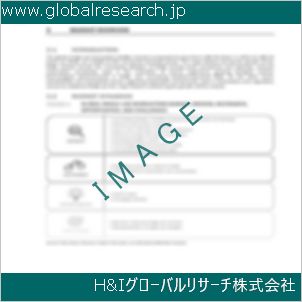1 市場概要
1.1 製品概要と範囲
1.2 市場推定の注意点と基準年
1.3 タイプ別市場分析
1.3.1 概要:グローバル クラス B 船舶搭載自動識別システム(AIS)の消費価値(タイプ別):2020年対2024年対2031年
1.3.2 携帯型AIS
1.3.3 固定式AIS
1.4 用途別市場分析
1.4.1 概要:グローバル クラスB 船舶搭載自動識別システム(AIS)の消費額(用途別):2020年対2024年対2031年
1.4.2 海洋漁業
1.4.3 スマート輸送
1.4.4 その他
1.5 グローバル クラスB 船舶搭載自動識別システム(AIS)市場規模と予測
1.5.1 グローバル クラスB 船舶搭載自動識別システム(AIS)の消費価値(2020年、2024年、2031年)
1.5.2 グローバル クラスB 船舶搭載自動識別システム(AIS)販売数量(2020-2031)
1.5.3 グローバル クラスB 船舶搭載自動識別システム(AIS)平均価格(2020-2031)
2 メーカープロファイル
2.1 日本無線
2.1.1 日本無線の詳細
2.1.2 日本無線の主要事業
2.1.3 日本無線 クラスB船舶用自動識別システム(AIS)製品およびサービス
2.1.4 日本無線 クラスB船舶用自動識別システム(AIS)の販売数量、平均価格、売上高、粗利益率、市場シェア(2020-2025)
2.1.5 日本無線の最近の動向/更新
2.2 Garmin
2.2.1 Garminの詳細
2.2.2 Garminの主要事業
2.2.3 Garmin クラスB船舶用自動識別システム(AIS)製品およびサービス
2.2.4 Garmin クラスB船載自動識別システム(AIS)の販売数量、平均価格、売上高、粗利益率、市場シェア(2020-2025)
2.2.5 Garminの最近の動向/更新
2.3 Xinuo 情報技術
2.3.1 Xinuo Information Technologyの詳細
2.3.2 Xinuo Information Technology 主な事業
2.3.3 Xinuo Information Technology クラスB船載自動識別システム(AIS)製品およびサービス
2.3.4 Xinuo Information Technology クラスB船舶用自動識別システム(AIS)の販売数量、平均価格、売上高、粗利益率、市場シェア(2020-2025)
2.3.5 Xinuo Information Technology の最近の動向/更新
2.4 福建飛通通信技術
2.4.1 福建飛通通信技術の詳細
2.4.2 福建飛通通信技術 主な事業
2.4.3 福建飛通通信技術 クラスB船舶用自動識別システム(AIS)製品およびサービス
2.4.4 福建飛通通信技術 クラスB船舶用自動識別システム(AIS)の販売数量、平均価格、売上高、粗利益率および市場シェア(2020-2025)
2.4.5 福建飛通通信技術の最新動向/更新情報
2.5 上海ユビキタスナビゲーションテクノロジー
2.5.1 上海ユビキタスナビゲーションテクノロジーの詳細
2.5.2 上海ユビキタスナビゲーションテクノロジー主要事業
2.5.3 上海ユビキタスナビゲーションテクノロジー クラスB船舶用自動識別システム(AIS)製品およびサービス
2.5.4 上海ユビキタスナビゲーションテクノロジー クラスB船舶用自動識別システム(AIS)の販売数量、平均価格、売上高、粗利益率、市場シェア(2020-2025)
2.5.5 上海ユビキタスナビゲーションテクノロジーの最近の動向/更新
2.6 南通サイヤン電子
2.6.1 南通サイヤン電子の詳細
2.6.2 南通サイヤン電子の主要事業
2.6.3 南通サイヤン電子 クラスB船舶用自動識別システム(AIS)製品およびサービス
2.6.4 南通サイヤン電子 クラスB船舶用自動識別システム(AIS)の販売数量、平均価格、売上高、粗利益率、市場シェア(2020-2025)
2.6.5 南通サイヤン電子の最近の動向/更新
2.7 広州ハイゲ通信
2.7.1 広州ハイゲ通信の詳細
2.7.2 広州ハイゲ通信の主要事業
2.7.3 広州ハイゲ通信 クラスB船舶用自動識別システム(AIS)製品およびサービス
2.7.4 広州ハイゲ通信 クラスB船舶用自動識別システム(AIS)の販売数量、平均価格、売上高、粗利益率、市場シェア(2020-2025)
2.7.5 広州ハイゲ通信の最近の動向/更新
2.8 上海アドバンスト・アビオニクス
2.8.1 上海アドバンスト・アビオニクス詳細
2.8.2 上海アドバンスト・アビオニクス 主な事業
2.8.3 上海アドバンスト・アビオニクス クラスB船載自動識別システム(AIS)製品およびサービス
2.8.4 上海アドバンスト・アビオニクス クラスB船載自動識別システム(AIS)の販売数量、平均価格、売上高、粗利益率、市場シェア(2020-2025)
2.8.5 上海先進航空電子機器の最近の動向/更新
2.9 BDStarナビゲーション
2.9.1 BDStar Navigationの詳細
2.9.2 BDStar Navigation 主な事業
2.9.3 BDStar Navigation クラスB船載自動識別システム(AIS)製品およびサービス
2.9.4 BDStar Navigation クラスB船載自動識別システム(AIS)の販売数量、平均価格、売上高、粗利益率、市場シェア(2020-2025)
2.9.5 BDStar Navigationの最近の動向/更新
2.10 Beidou Tianhui
2.10.1 Beidou Tianhui 詳細
2.10.2 Beidou Tianhui 主な事業
2.10.3 Beidou Tianhui クラスB船載自動識別システム(AIS)製品およびサービス
2.10.4 Beidou Tianhui クラスB船載自動識別システム(AIS)の販売数量、平均価格、売上高、粗利益率、市場シェア(2020-2025)
2.10.5 Beidou Tianhui の最近の動向/更新
2.11 NSR Marine
2.11.1 NSR Marineの詳細
2.11.2 NSR Marine 主な事業
2.11.3 NSR Marine クラスB船載自動識別システム(AIS)製品およびサービス
2.11.4 NSR Marine クラスB船載自動識別システム(AIS)の販売数量、平均価格、売上高、粗利益率、市場シェア(2020-2025)
2.11.5 NSR Marineの最近の動向/更新
2.12 江蘇アンハン海洋機器
2.12.1 江蘇アンハン海洋機器の詳細
2.12.2 江蘇アンハン海洋機器の主要事業
2.12.3 江蘇アンハン海洋機器 クラスB船載自動識別システム(AIS)製品およびサービス
2.12.4 江蘇アンハン海洋機器 クラスB船載自動識別システム(AIS)の販売数量、平均価格、売上高、粗利益率、市場シェア(2020-2025)
2.12.5 江蘇アンハン海洋機器の最近の動向/更新
3 競争環境:クラスB船舶用自動識別システム(AIS)メーカー別
3.1 グローバル クラスB 船舶搭載自動識別システム(AIS)の製造業者別販売数量(2020-2025)
3.2 グローバル クラスB船載自動識別システム(AIS)の売上高(メーカー別)(2020-2025)
3.3 グローバル クラスB船載自動識別システム(AIS)メーカー別平均価格(2020-2025)
3.4 市場シェア分析(2024年)
3.4.1 製造メーカー別クラスB船舶用自動識別システム(AIS)の出荷量、売上高($MM)および市場シェア(%):2024
3.4.2 2024年のクラスB船舶用自動識別システム(AIS)メーカー別市場シェア上位3社
3.4.3 2024年のクラスB船舶用自動識別システム(AIS)メーカー市場シェア上位6社
3.5 クラスB船舶搭載自動識別システム(AIS)市場:全体的な企業足跡分析
3.5.1 クラスB船舶搭載自動識別システム(AIS)市場:地域別足跡
3.5.2 クラスB船舶搭載自動識別システム(AIS)市場:企業製品タイプ別足跡
3.5.3 クラスB船舶搭載自動識別システム(AIS)市場:企業製品用途別足跡
3.6 新規参入企業と市場参入障壁
3.7 合併、買収、合意、および協力関係
4 地域別消費分析
4.1 地域別グローバルクラスB船舶搭載自動識別システム(AIS)市場規模
4.1.1 地域別グローバルクラスB船舶搭載自動識別システム(AIS)販売数量(2020-2031)
4.1.2 地域別グローバルクラスB船舶搭載自動識別システム(AIS)の消費額(2020-2031)
4.1.3 地域別グローバルクラスB船舶搭載自動識別システム(AIS)平均価格(2020-2031)
4.2 北米地域別クラスB船舶用自動識別システム(AIS)消費額(2020-2031)
4.3 欧州 クラスB船載自動識別システム(AIS)の消費額(2020-2031)
4.4 アジア太平洋地域 クラスB船舶用自動識別システム(AIS)消費額(2020-2031)
4.5 南米 クラスB 船舶搭載自動識別システム(AIS)消費額(2020-2031)
4.6 中東・アフリカ地域 クラスB船舶用自動識別システム(AIS)の消費額(2020-2031)
5 市場セグメント別タイプ
5.1 グローバル クラスB 船舶搭載型自動識別システム(AIS)のタイプ別販売数量(2020-2031)
5.2 グローバル クラスB 船舶搭載型自動識別システム(AIS)の消費額(タイプ別)(2020-2031)
5.3 グローバル クラスB 船舶搭載自動識別システム(AIS)の平均価格(種類別)(2020-2031)
6 市場セグメント別(用途)
6.1 グローバル クラスB 船舶搭載型自動識別システム(AIS)のアプリケーション別販売数量(2020-2031)
6.2 グローバル クラスB 船舶搭載自動識別システム(AIS)の用途別消費額(2020-2031)
6.3 グローバル クラスB 船舶搭載自動識別システム(AIS)の平均価格(用途別)(2020-2031)
7 北米
7.1 北米 クラスB船舶搭載自動識別システム(AIS)の売上数量(用途別)(2020-2031)
7.2 北米 クラスB船載自動識別システム(AIS)のアプリケーション別販売数量(2020-2031)
7.3 北米 クラスB船舶搭載自動識別システム(AIS)市場規模(国別)
7.3.1 北米 クラスB 船舶用自動識別システム(AIS)の販売数量(国別)(2020-2031)
7.3.2 北米 クラスB 船舶用自動識別システム(AIS)の消費額(国別)(2020-2031)
7.3.3 アメリカ市場規模と予測(2020-2031)
7.3.4 カナダ市場規模と予測(2020-2031)
7.3.5 メキシコ市場規模と予測(2020-2031)
8 ヨーロッパ
8.1 ヨーロッパ クラスB 船舶搭載自動識別システム(AIS)のタイプ別販売数量(2020-2031)
8.2 欧州クラスB船舶搭載自動識別システム(AIS)のアプリケーション別販売数量(2020-2031)
8.3 欧州クラスB船舶搭載自動識別システム(AIS)市場規模(国別)
8.3.1 欧州 クラスB船舶搭載自動識別システム(AIS)の販売数量(国別)(2020-2031)
8.3.2 欧州クラスB船舶搭載自動識別システム(AIS)の消費額(国別)(2020-2031)
8.3.3 ドイツ市場規模と予測(2020-2031)
8.3.4 フランス市場規模と予測(2020-2031)
8.3.5 イギリス市場規模と予測(2020-2031)
8.3.6 ロシア市場規模と予測(2020-2031)
8.3.7 イタリア市場規模と予測(2020-2031)
9 アジア太平洋
9.1 アジア太平洋地域 クラスB船載自動識別システム(AIS)の売上数量(種類別)(2020-2031)
9.2 アジア太平洋地域 クラスB船舶用自動識別システム(AIS)のアプリケーション別販売数量(2020-2031)
9.3 アジア太平洋地域 クラスB船舶搭載自動識別システム(AIS)市場規模(地域別)
9.3.1 アジア太平洋地域 クラスB船舶用自動識別システム(AIS)の地域別販売数量(2020-2031)
9.3.2 アジア太平洋地域 クラスB 船舶用自動識別システム(AIS)の地域別消費額(2020-2031)
9.3.3 中国市場規模と予測(2020-2031)
9.3.4 日本市場規模と予測(2020-2031)
9.3.5 韓国市場規模と予測(2020-2031)
9.3.6 インド市場規模と予測(2020-2031)
9.3.7 東南アジア市場規模と予測(2020-2031)
9.3.8 オーストラリア市場規模と予測(2020-2031)
10 南米
10.1 南米 クラスB船載自動識別システム(AIS)の売上数量(タイプ別)(2020-2031)
10.2 南米 クラスB船載自動識別システム(AIS)のアプリケーション別販売数量(2020-2031)
10.3 南米 クラスB船舶用自動識別システム(AIS)市場規模(国別)
10.3.1 南米 クラスB 船舶搭載型自動識別システム(AIS)の販売数量(国別)(2020-2031)
10.3.2 南米 クラスB 船舶搭載自動識別システム(AIS)の消費額(国別)(2020-2031)
10.3.3 ブラジル市場規模と予測(2020-2031)
10.3.4 アルゼンチン市場規模と予測(2020-2031)
11 中東・アフリカ
11.1 中東・アフリカ地域 クラスB船舶搭載自動識別システム(AIS)販売数量(種類別)(2020-2031)
11.2 中東・アフリカ クラスB船舶用自動識別システム(AIS)のアプリケーション別販売数量(2020-2031)
11.3 中東・アフリカ クラスB船載自動識別システム(AIS)市場規模(国別)
11.3.1 中東・アフリカ地域 クラスB船載自動識別システム(AIS)販売数量(国別)(2020-2031)
11.3.2 中東・アフリカ地域 クラスB船舶用自動識別システム(AIS)の消費額(国別)(2020-2031)
11.3.3 トルコ市場規模と予測(2020-2031)
11.3.4 エジプト市場規模と予測(2020-2031)
11.3.5 サウジアラビア市場規模と予測(2020-2031)
11.3.6 南アフリカ市場規模と予測(2020-2031)
12 市場動向
12.1 クラスB船載自動識別システム(AIS)市場ドライバー
12.2 クラスB船載自動識別システム(AIS)市場の制約要因
12.3 クラスB船載自動識別システム(AIS)の動向分析
12.4 ポーターの5つの力分析
12.4.1 新規参入の脅威
12.4.2 供給者の交渉力
12.4.3 購入者の交渉力
12.4.4 代替品の脅威
12.4.5 競争の激化
13 原材料と産業チェーン
13.1 クラスB船載自動識別システム(AIS)の原材料と主要メーカー
13.2 クラスB船舶用自動識別システム(AIS)の製造コストの割合
13.3 クラスB船舶用自動識別システム(AIS)の製造プロセス
13.4 産業バリューチェーン分析
14 流通チャネル別出荷量
14.1 販売チャネル
14.1.1 直接エンドユーザー向け
14.1.2 卸売業者
14.2 クラスB船載自動識別システム(AIS)の典型的な販売代理店
14.3 クラスB船舶用自動識別システム(AIS)の典型的な顧客
15 研究結果と結論
16 付録
16.1 方法論
16.2 研究プロセスとデータソース
16.3 免責事項
1.1 Product Overview and Scope
1.2 Market Estimation Caveats and Base Year
1.3 Market Analysis by Type
1.3.1 Overview: Global Class B Shipborne Automatic Identification System (AIS) Consumption Value by Type: 2020 Versus 2024 Versus 2031
1.3.2 Portable AIS
1.3.3 Fixed AIS
1.4 Market Analysis by Application
1.4.1 Overview: Global Class B Shipborne Automatic Identification System (AIS) Consumption Value by Application: 2020 Versus 2024 Versus 2031
1.4.2 Marine Fishery
1.4.3 Intelligent Shipping
1.4.4 Others
1.5 Global Class B Shipborne Automatic Identification System (AIS) Market Size & Forecast
1.5.1 Global Class B Shipborne Automatic Identification System (AIS) Consumption Value (2020 & 2024 & 2031)
1.5.2 Global Class B Shipborne Automatic Identification System (AIS) Sales Quantity (2020-2031)
1.5.3 Global Class B Shipborne Automatic Identification System (AIS) Average Price (2020-2031)
2 Manufacturers Profiles
2.1 Japan Radio
2.1.1 Japan Radio Details
2.1.2 Japan Radio Major Business
2.1.3 Japan Radio Class B Shipborne Automatic Identification System (AIS) Product and Services
2.1.4 Japan Radio Class B Shipborne Automatic Identification System (AIS) Sales Quantity, Average Price, Revenue, Gross Margin and Market Share (2020-2025)
2.1.5 Japan Radio Recent Developments/Updates
2.2 Garmin
2.2.1 Garmin Details
2.2.2 Garmin Major Business
2.2.3 Garmin Class B Shipborne Automatic Identification System (AIS) Product and Services
2.2.4 Garmin Class B Shipborne Automatic Identification System (AIS) Sales Quantity, Average Price, Revenue, Gross Margin and Market Share (2020-2025)
2.2.5 Garmin Recent Developments/Updates
2.3 Xinuo Information Technology
2.3.1 Xinuo Information Technology Details
2.3.2 Xinuo Information Technology Major Business
2.3.3 Xinuo Information Technology Class B Shipborne Automatic Identification System (AIS) Product and Services
2.3.4 Xinuo Information Technology Class B Shipborne Automatic Identification System (AIS) Sales Quantity, Average Price, Revenue, Gross Margin and Market Share (2020-2025)
2.3.5 Xinuo Information Technology Recent Developments/Updates
2.4 Fujian Feitong Communication Technology
2.4.1 Fujian Feitong Communication Technology Details
2.4.2 Fujian Feitong Communication Technology Major Business
2.4.3 Fujian Feitong Communication Technology Class B Shipborne Automatic Identification System (AIS) Product and Services
2.4.4 Fujian Feitong Communication Technology Class B Shipborne Automatic Identification System (AIS) Sales Quantity, Average Price, Revenue, Gross Margin and Market Share (2020-2025)
2.4.5 Fujian Feitong Communication Technology Recent Developments/Updates
2.5 Shanghai Ubiquitous Navigation Technology
2.5.1 Shanghai Ubiquitous Navigation Technology Details
2.5.2 Shanghai Ubiquitous Navigation Technology Major Business
2.5.3 Shanghai Ubiquitous Navigation Technology Class B Shipborne Automatic Identification System (AIS) Product and Services
2.5.4 Shanghai Ubiquitous Navigation Technology Class B Shipborne Automatic Identification System (AIS) Sales Quantity, Average Price, Revenue, Gross Margin and Market Share (2020-2025)
2.5.5 Shanghai Ubiquitous Navigation Technology Recent Developments/Updates
2.6 Nantong Saiyang Electronics
2.6.1 Nantong Saiyang Electronics Details
2.6.2 Nantong Saiyang Electronics Major Business
2.6.3 Nantong Saiyang Electronics Class B Shipborne Automatic Identification System (AIS) Product and Services
2.6.4 Nantong Saiyang Electronics Class B Shipborne Automatic Identification System (AIS) Sales Quantity, Average Price, Revenue, Gross Margin and Market Share (2020-2025)
2.6.5 Nantong Saiyang Electronics Recent Developments/Updates
2.7 Guangzhou Haige Communications
2.7.1 Guangzhou Haige Communications Details
2.7.2 Guangzhou Haige Communications Major Business
2.7.3 Guangzhou Haige Communications Class B Shipborne Automatic Identification System (AIS) Product and Services
2.7.4 Guangzhou Haige Communications Class B Shipborne Automatic Identification System (AIS) Sales Quantity, Average Price, Revenue, Gross Margin and Market Share (2020-2025)
2.7.5 Guangzhou Haige Communications Recent Developments/Updates
2.8 Shanghai Advanced Avionics
2.8.1 Shanghai Advanced Avionics Details
2.8.2 Shanghai Advanced Avionics Major Business
2.8.3 Shanghai Advanced Avionics Class B Shipborne Automatic Identification System (AIS) Product and Services
2.8.4 Shanghai Advanced Avionics Class B Shipborne Automatic Identification System (AIS) Sales Quantity, Average Price, Revenue, Gross Margin and Market Share (2020-2025)
2.8.5 Shanghai Advanced Avionics Recent Developments/Updates
2.9 BDStar Navigation
2.9.1 BDStar Navigation Details
2.9.2 BDStar Navigation Major Business
2.9.3 BDStar Navigation Class B Shipborne Automatic Identification System (AIS) Product and Services
2.9.4 BDStar Navigation Class B Shipborne Automatic Identification System (AIS) Sales Quantity, Average Price, Revenue, Gross Margin and Market Share (2020-2025)
2.9.5 BDStar Navigation Recent Developments/Updates
2.10 Beidou Tianhui
2.10.1 Beidou Tianhui Details
2.10.2 Beidou Tianhui Major Business
2.10.3 Beidou Tianhui Class B Shipborne Automatic Identification System (AIS) Product and Services
2.10.4 Beidou Tianhui Class B Shipborne Automatic Identification System (AIS) Sales Quantity, Average Price, Revenue, Gross Margin and Market Share (2020-2025)
2.10.5 Beidou Tianhui Recent Developments/Updates
2.11 NSR Marine
2.11.1 NSR Marine Details
2.11.2 NSR Marine Major Business
2.11.3 NSR Marine Class B Shipborne Automatic Identification System (AIS) Product and Services
2.11.4 NSR Marine Class B Shipborne Automatic Identification System (AIS) Sales Quantity, Average Price, Revenue, Gross Margin and Market Share (2020-2025)
2.11.5 NSR Marine Recent Developments/Updates
2.12 Jiangsu Anhang Marine Equipment
2.12.1 Jiangsu Anhang Marine Equipment Details
2.12.2 Jiangsu Anhang Marine Equipment Major Business
2.12.3 Jiangsu Anhang Marine Equipment Class B Shipborne Automatic Identification System (AIS) Product and Services
2.12.4 Jiangsu Anhang Marine Equipment Class B Shipborne Automatic Identification System (AIS) Sales Quantity, Average Price, Revenue, Gross Margin and Market Share (2020-2025)
2.12.5 Jiangsu Anhang Marine Equipment Recent Developments/Updates
3 Competitive Environment: Class B Shipborne Automatic Identification System (AIS) by Manufacturer
3.1 Global Class B Shipborne Automatic Identification System (AIS) Sales Quantity by Manufacturer (2020-2025)
3.2 Global Class B Shipborne Automatic Identification System (AIS) Revenue by Manufacturer (2020-2025)
3.3 Global Class B Shipborne Automatic Identification System (AIS) Average Price by Manufacturer (2020-2025)
3.4 Market Share Analysis (2024)
3.4.1 Producer Shipments of Class B Shipborne Automatic Identification System (AIS) by Manufacturer Revenue ($MM) and Market Share (%): 2024
3.4.2 Top 3 Class B Shipborne Automatic Identification System (AIS) Manufacturer Market Share in 2024
3.4.3 Top 6 Class B Shipborne Automatic Identification System (AIS) Manufacturer Market Share in 2024
3.5 Class B Shipborne Automatic Identification System (AIS) Market: Overall Company Footprint Analysis
3.5.1 Class B Shipborne Automatic Identification System (AIS) Market: Region Footprint
3.5.2 Class B Shipborne Automatic Identification System (AIS) Market: Company Product Type Footprint
3.5.3 Class B Shipborne Automatic Identification System (AIS) Market: Company Product Application Footprint
3.6 New Market Entrants and Barriers to Market Entry
3.7 Mergers, Acquisition, Agreements, and Collaborations
4 Consumption Analysis by Region
4.1 Global Class B Shipborne Automatic Identification System (AIS) Market Size by Region
4.1.1 Global Class B Shipborne Automatic Identification System (AIS) Sales Quantity by Region (2020-2031)
4.1.2 Global Class B Shipborne Automatic Identification System (AIS) Consumption Value by Region (2020-2031)
4.1.3 Global Class B Shipborne Automatic Identification System (AIS) Average Price by Region (2020-2031)
4.2 North America Class B Shipborne Automatic Identification System (AIS) Consumption Value (2020-2031)
4.3 Europe Class B Shipborne Automatic Identification System (AIS) Consumption Value (2020-2031)
4.4 Asia-Pacific Class B Shipborne Automatic Identification System (AIS) Consumption Value (2020-2031)
4.5 South America Class B Shipborne Automatic Identification System (AIS) Consumption Value (2020-2031)
4.6 Middle East & Africa Class B Shipborne Automatic Identification System (AIS) Consumption Value (2020-2031)
5 Market Segment by Type
5.1 Global Class B Shipborne Automatic Identification System (AIS) Sales Quantity by Type (2020-2031)
5.2 Global Class B Shipborne Automatic Identification System (AIS) Consumption Value by Type (2020-2031)
5.3 Global Class B Shipborne Automatic Identification System (AIS) Average Price by Type (2020-2031)
6 Market Segment by Application
6.1 Global Class B Shipborne Automatic Identification System (AIS) Sales Quantity by Application (2020-2031)
6.2 Global Class B Shipborne Automatic Identification System (AIS) Consumption Value by Application (2020-2031)
6.3 Global Class B Shipborne Automatic Identification System (AIS) Average Price by Application (2020-2031)
7 North America
7.1 North America Class B Shipborne Automatic Identification System (AIS) Sales Quantity by Type (2020-2031)
7.2 North America Class B Shipborne Automatic Identification System (AIS) Sales Quantity by Application (2020-2031)
7.3 North America Class B Shipborne Automatic Identification System (AIS) Market Size by Country
7.3.1 North America Class B Shipborne Automatic Identification System (AIS) Sales Quantity by Country (2020-2031)
7.3.2 North America Class B Shipborne Automatic Identification System (AIS) Consumption Value by Country (2020-2031)
7.3.3 United States Market Size and Forecast (2020-2031)
7.3.4 Canada Market Size and Forecast (2020-2031)
7.3.5 Mexico Market Size and Forecast (2020-2031)
8 Europe
8.1 Europe Class B Shipborne Automatic Identification System (AIS) Sales Quantity by Type (2020-2031)
8.2 Europe Class B Shipborne Automatic Identification System (AIS) Sales Quantity by Application (2020-2031)
8.3 Europe Class B Shipborne Automatic Identification System (AIS) Market Size by Country
8.3.1 Europe Class B Shipborne Automatic Identification System (AIS) Sales Quantity by Country (2020-2031)
8.3.2 Europe Class B Shipborne Automatic Identification System (AIS) Consumption Value by Country (2020-2031)
8.3.3 Germany Market Size and Forecast (2020-2031)
8.3.4 France Market Size and Forecast (2020-2031)
8.3.5 United Kingdom Market Size and Forecast (2020-2031)
8.3.6 Russia Market Size and Forecast (2020-2031)
8.3.7 Italy Market Size and Forecast (2020-2031)
9 Asia-Pacific
9.1 Asia-Pacific Class B Shipborne Automatic Identification System (AIS) Sales Quantity by Type (2020-2031)
9.2 Asia-Pacific Class B Shipborne Automatic Identification System (AIS) Sales Quantity by Application (2020-2031)
9.3 Asia-Pacific Class B Shipborne Automatic Identification System (AIS) Market Size by Region
9.3.1 Asia-Pacific Class B Shipborne Automatic Identification System (AIS) Sales Quantity by Region (2020-2031)
9.3.2 Asia-Pacific Class B Shipborne Automatic Identification System (AIS) Consumption Value by Region (2020-2031)
9.3.3 China Market Size and Forecast (2020-2031)
9.3.4 Japan Market Size and Forecast (2020-2031)
9.3.5 South Korea Market Size and Forecast (2020-2031)
9.3.6 India Market Size and Forecast (2020-2031)
9.3.7 Southeast Asia Market Size and Forecast (2020-2031)
9.3.8 Australia Market Size and Forecast (2020-2031)
10 South America
10.1 South America Class B Shipborne Automatic Identification System (AIS) Sales Quantity by Type (2020-2031)
10.2 South America Class B Shipborne Automatic Identification System (AIS) Sales Quantity by Application (2020-2031)
10.3 South America Class B Shipborne Automatic Identification System (AIS) Market Size by Country
10.3.1 South America Class B Shipborne Automatic Identification System (AIS) Sales Quantity by Country (2020-2031)
10.3.2 South America Class B Shipborne Automatic Identification System (AIS) Consumption Value by Country (2020-2031)
10.3.3 Brazil Market Size and Forecast (2020-2031)
10.3.4 Argentina Market Size and Forecast (2020-2031)
11 Middle East & Africa
11.1 Middle East & Africa Class B Shipborne Automatic Identification System (AIS) Sales Quantity by Type (2020-2031)
11.2 Middle East & Africa Class B Shipborne Automatic Identification System (AIS) Sales Quantity by Application (2020-2031)
11.3 Middle East & Africa Class B Shipborne Automatic Identification System (AIS) Market Size by Country
11.3.1 Middle East & Africa Class B Shipborne Automatic Identification System (AIS) Sales Quantity by Country (2020-2031)
11.3.2 Middle East & Africa Class B Shipborne Automatic Identification System (AIS) Consumption Value by Country (2020-2031)
11.3.3 Turkey Market Size and Forecast (2020-2031)
11.3.4 Egypt Market Size and Forecast (2020-2031)
11.3.5 Saudi Arabia Market Size and Forecast (2020-2031)
11.3.6 South Africa Market Size and Forecast (2020-2031)
12 Market Dynamics
12.1 Class B Shipborne Automatic Identification System (AIS) Market Drivers
12.2 Class B Shipborne Automatic Identification System (AIS) Market Restraints
12.3 Class B Shipborne Automatic Identification System (AIS) Trends Analysis
12.4 Porters Five Forces Analysis
12.4.1 Threat of New Entrants
12.4.2 Bargaining Power of Suppliers
12.4.3 Bargaining Power of Buyers
12.4.4 Threat of Substitutes
12.4.5 Competitive Rivalry
13 Raw Material and Industry Chain
13.1 Raw Material of Class B Shipborne Automatic Identification System (AIS) and Key Manufacturers
13.2 Manufacturing Costs Percentage of Class B Shipborne Automatic Identification System (AIS)
13.3 Class B Shipborne Automatic Identification System (AIS) Production Process
13.4 Industry Value Chain Analysis
14 Shipments by Distribution Channel
14.1 Sales Channel
14.1.1 Direct to End-User
14.1.2 Distributors
14.2 Class B Shipborne Automatic Identification System (AIS) Typical Distributors
14.3 Class B Shipborne Automatic Identification System (AIS) Typical Customers
15 Research Findings and Conclusion
16 Appendix
16.1 Methodology
16.2 Research Process and Data Source
16.3 Disclaimer
| ※参考情報 クラスB船舶自動識別システム(AIS)は、海上の船舶の位置や航行情報を自動的に収集・送信するための重要な技術です。AISは、特に海運業界において重要な役割を果たすものであり、船舶の安全性向上や運行の効率化に寄与します。本システムは、商業船舶だけでなく、レクリエーションボートや小型漁船などさまざまなタイプの船舶に搭載可能です。 クラスB AISは、船舶の追跡や管理を目的として設計されており、クラスA AISに比べて簡易的な設計がなされています。クラスA AISは商業航行用に高機能であり、国際海事機関(IMO)の基準に基づいて運用されていますが、クラスBは主に小型船舶を対象としており、最低限の機能を持ちながらも必要な情報を提供します。 クラスB AISの特徴としては、まず、その通信範囲が挙げられます。一般的に、クラスB AISは約20海里の範囲での通信を行い、周囲の船舶や岸上の監視機関と情報を交換できます。また、クラスB AISは、GPS受信機と組み合わせて使用され、船舶の正確な位置情報を提供します。これにより、他の船舶や岸上の施設は、リアルタイムで船舶の位置、航行方向、速度などの情報を把握できます。 さらに、クラスB AISは、その構造がシンプルであるため、導入コストが低いことも特筆すべき点です。小型のレクリエーションボートや漁船でも導入が容易であり、結果的に多くの船舶がAISを搭載することを可能にしています。これにより、海上の安全性が向上し、衝突のリスクを低減することにつながります。 クラスB AISには、通常、いくつかの種類があり、その機能によって異なる分類がされています。主な機種としては、基本的なAISトランスポンダー、衛星通信機能を持つ機器、そして、携帯型の小型AISデバイスなどがあります。特に、携帯型のAISデバイスは、操船者が容易に持ち運びできるため、釣りやクルージングの際に便利です。 クラスB AISの用途も多岐にわたりますが、主な目的は海難防止と運行の効率化です。例えば、漁業においては、漁船が他の船舶とその位置を共有することで衝突を避け、漁場を効果的に利用することができます。また、レクリエーションボートにおいては、同様に周辺の船舶との情報共有を行い、より安全に航行することが可能です。 AISの機能として、船舶の位置情報の他に、船名、コールサイン、船舶の種類、運行の状態、航行区域なども含まれます。これにより、他の船舶や監視機関は、船舶の特性や運行状況を把握しやすくなります。特に、AISに基づく情報は、船舶同士の相互作用を向上させ、円滑な航行を促進する要因となります。 関連技術としては、GPS技術やVHF無線通信が挙げられます。AISの基盤はGPSであり、正確な位置情報を提供することで、船舶の動きをリアルタイムで追跡可能にします。また、VHF無線通信により、AISデータを他の船舶や岸上に送信することができ、これにより、情報の伝達が迅速かつ確実に行われます。これらの技術が組み合わさることで、クラスB AISはより効果的に運用されています。 さらに、近年ではAISデータを利用した津波警報システムや海難救助などの目的にも利用されています。AISの情報は、海域の監視において非常に貴重であり、事故防止や救助活動における迅速な対応を可能にします。これにより、国や地域によっては、AISデータを基にした新たなサービスやシステムが開発されています。 また、クラスB AISの導入は、法的な要求という側面も持っています。一部の国では、特定のサイズやタイプの船舶に対してAISの搭載が義務付けられており、この流れは今後も続くと考えられます。船舶所有者にとっては、法令遵守の観点からもAISの導入が望ましいと言えるでしょう。 以上のように、クラスB船舶自動識別システムは、船舶の安全で効率的な航行に寄与する重要な技術です。その特徴や用途、関連技術について理解を深めることは、海運業界のみならず、一般の航行者にとっても非常に重要です。みんながAISを活用し、安全で快適な海上活動を行うことができる事が望まれます。AIS技術の進化が今後の海上交通の安全性向上に寄与していくことを期待しています。 |
❖ 免責事項 ❖
http://www.globalresearch.jp/disclaimer












